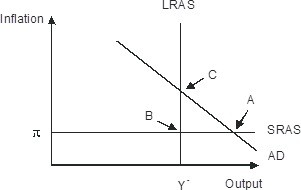Firm A is a monopoly because of network effects, whereas Firm B is a natural monopoly. Which of the following statements is likely to be true in this context?
A) The average total costs of both firms decrease as they increase their output.
B) The value of the product that both firms produce increases with an increase in the number of buyers.
C) Firm A enjoys a monopoly status because its average total cost decreases with increase in output, whereas Firm B enjoys a monopoly status because the value of its product increases as more consumers buy it.
D) Firm B enjoys a monopoly status because its average total cost decreases with increase in output, whereas Firm A enjoys a monopoly status because the value of its product increases as more consumers buy it.
D
You might also like to view...
Refer to the figure below. In response to gradually falling inflation, this economy will eventually move from its short-run equilibrium to its long-run equilibrium. Graphically, this would be seen as 
A. long-run aggregate supply shifting leftward B. Short-run aggregate supply shifting upward C. Short-run aggregate supply shifting downward D. Aggregate demand shifting leftward
Labor productivity is measured as:
a. the share of wages in national income. b. the change in labor to capital ratio. c. real output per labor hour. d. the change in output from hiring an additional unit of labor. e. the growth in the quantity of labor.
The exchange rate of a currency will increase if the quantity demanded exceeds quantity supplied at the current exchange rate
a. True b. False Indicate whether the statement is true or false
If a disequilibrium occurs in the foreign exchange market, what are possible solutions? Why might governments choose not to let the price of their currencies adjust to clear the market?